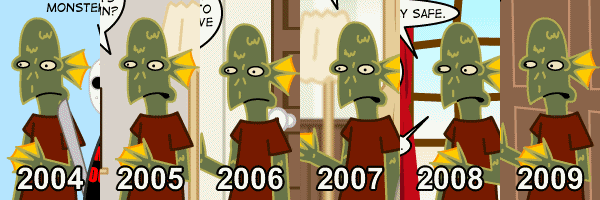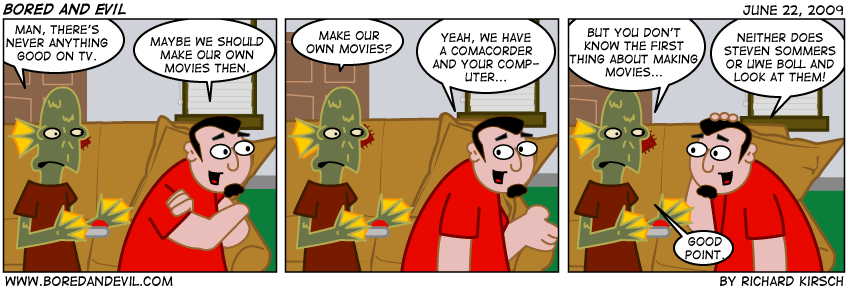Bored and Evil
| Original review author: | Truthfulpietro |
| Webcomic name: | Bored and Evil |
| Author: | Robert Koch until December 2006, then Richard Kirsch |
| Start Date: | June 7, 2004 |
| End Date: | August 10, 2009 |
| Genre: | Comedy |
| Defining Flaw: | Gag-a-day comic that fails to amuse. |
Rating Summary
| Art | 
Artwork outdoing Ctrl+Alt+Del in terms of Lazily Assembled Artwork even for its time. |
| Storyline: | 
Gag-A-Day style comedy that each story arc lasts at least 3 pages that always and I mean "ALWAYS" boils down to one punchline: Joe is a Loser. |
| Characters: | 
You're more likely to learn about them on the Character bio section then the comic itself. Joe is clearly a self-insert of the author. |
| Miscellaneous Details: | 
Author recommends the similarly awful Dueling Analogs. |
| Overall: | 
A webcomic so bad that Enter the Dream (a webcomic review site that gave praise to Better Days and Dominic Deegan) said it sucked. Not one positive review. |
Background
I found out about this comic through Enter the Dream, the Webcomic book club, a Webcomic review website that died by the end of 2005 as they stopped posting reviews by then. Entering the main site gives you this instead. However, the reviews are still online and most of the webcomics they mention can still be seen. Quite a few of the webcomics listed there are on this wiki so let's take a look at what they thought about them:
Better Days received virtually unanimous praise. Dominic Deegan has also received some positive word of mouth. Jack has definitely received a mixed reception. Unicorn Jelly's are not so lenient either.
Now with that out of the way I give you Bored and Evil. It has 3 reviews on Enter the Dream, all of which are from, more or less the same reviewers of the reviews I've shown before and none of which are positive. And despite lasting longer then Enter the Dream, and still staying online despite being finished. It's still not funny.
Story and Plot
The basic premise is that a man named Joe has sold his soul to lower his apartment rent, and the catch is that he must live with monsters. Not only are these monsters sarcastic, they relentlessly pick on Joe. This is all the comic has been doing throughout its history.
Downfall
The comic started poorly to begin with. It started off with jokes that were done to death even for its time, ranging from being white as a sheet, twice, to a tentacle joke. Names weren't revealed until a few pages in either. But then Joe, whose name was not revealed until that point in the comic, gets an email saying that he got instructions by a company to leave $1,000 in a brown bag onto a bench in the park, then we see Jake, saying that he's going for a walk in the park. Let that set in tone for the rest of the comic.
Art review
The artwork manages to outdo the laziness of Ctrl+Alt+Del. No, seriously. During the first year, all of the backgrounds are a single solid color. However, the color often changes between strips, even if two strips take place in the same location, as if the walls have some kind of chameleon paint job. In 2005, Robert starts to put in actual backgrounds (but not before lampshading it), but they're so flat and simplistic that they don't even matter. In late 2006, he starts adding gradients to create the illusion of depth.
As for the characters, every one of them is composed of pre-drawn elements clicked-and-dragged from a library. And I don't mean like Ctrl+Alt+Del. Bored and Evil takes it to a new level by giving each character maybe three or four poses each. Goonie is probably the worst example. He has one standing pose and the only thing that ever changes is that his arms bend at a right angle. Nothing else ever changes, not even his facial expressions. Oh, I'm sorry, he does bend his arms at a sharper angle when using a phone or a trumpet.

As for the main character, Joe, his range of motion also consists of about four poses. He can stand with his arms outstretched as if holding a videogame controller, raised up in the air, or crossed, and for some reason, one of his hands disappears when he does that. The only thing positive that can be said about him is that he changes his shirt.
Writing review
Remember what I said in the "Downfall" section where Joe went off to leave $1,000 dollars in a brown paper bag at the park, only to see Jake go for "a walk in the park" and for that to set the tone for the rest of the comic? I wasn't joking. The primary joke behind that was that Joe is the most pathetic loser on Earth, and they REPEAT this joke, over and over and over again until... ah screw it. They do this joke all the way to the final page of the comic where Joe accidentally presses a doomsday button. It's also the only recurring joke.
You simply don't do this to a gag-a-day comic for two reasons beyond just laziness. First of all, it doesn't matter how funny a joke is. If you keep repeating the same joke over and over again, it WILL get irritating. In Bored and Evil's case, the joke was not funny to begin with because Joe doesn't have any rhyme, rhythm, or reason to be a loser, making this running joke have no irony, insightfulness, or anything remotely amusing. Second, even if there was any of that, you need more than one recurring joke. You need to develop at least several to keep the viewers guessing and recognize a pattern. It shows that you are trying to be creative and experiment on the subject matter you are trying to make fun of.
Even without the "Joe is a loser" jokes, the humor is inept to an embarrassing degree. Bored and Evil introduces story arcs that would range of up to a minimum of three pages to a maximum of fifteen. Each story arc could range from introducing characters, political jokes, racial stereotypes, pedophilia, and Jesus, because all monster comics need a Jesus joke, or for that matter, or any kind of religion, right? Anyway, each story arc is an introduction for something that is a problem, then it gets resolved in a way that either leaves no lasting impact or a punchline that can be anticipated the minute you understand what's happening. Either that, or they introduce something that's supposed to be funny and they repeat the joke, TWICE!

Robert has also been known to make "celebrity guests" appear in his comic. When this happens, the "celebrity guest" consists of a random photo of their face stolen from Google Image Search and pasted onto a generic body.
Bored and Evil has also humor written by Robert's friends, Paul Tye, Richard Kirsch, and Steve Napierski, the sophomoric creator of Dueling Analogs.
Outside the retarded humor, it seems Robert would use Joe as his opinion mouthpiece, as seen here, where he comments on the remake of the Texas Chainsaw Massacre, and Joe dressing up as the main character of the Dark Tower series.
Author biography
Robert Koch once did an interview about Bored and Evil in 2005. Robert has also posted a five-star review of his comic, proclaiming himself as the writer. Robert would later leave this comic to create Spunky Brew on October 5, 2010, which also deserves a place here on this wiki. However I think it's Steve Napierski of Dueling Analogs fame that strikes me as the de facto idiot. He has been trying hard to get Bored and Evil some publicity, going so far as to request reviews on Enter the Dream.
As for Richard Kirsch, this is all I could find out about him:
Conclusion
Robert proves to us that he is a loser almost too well.